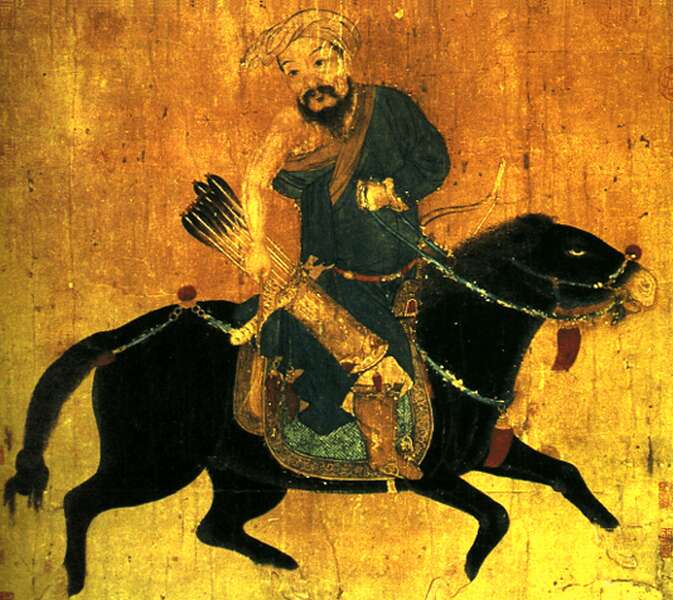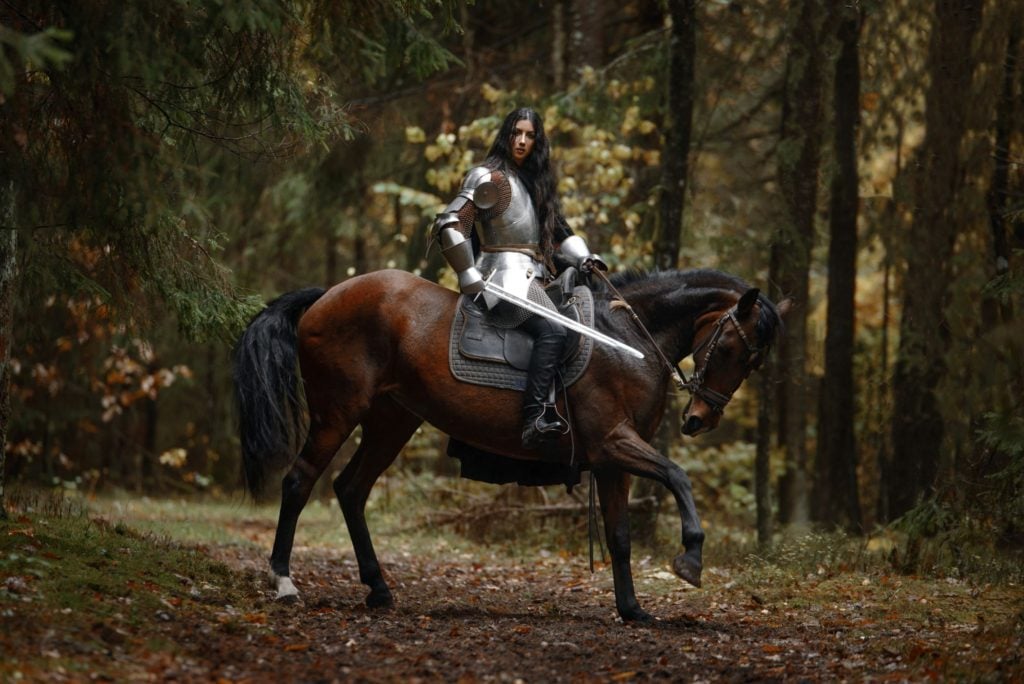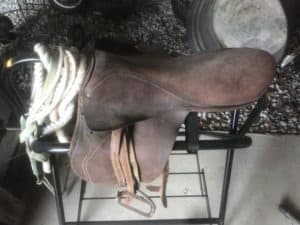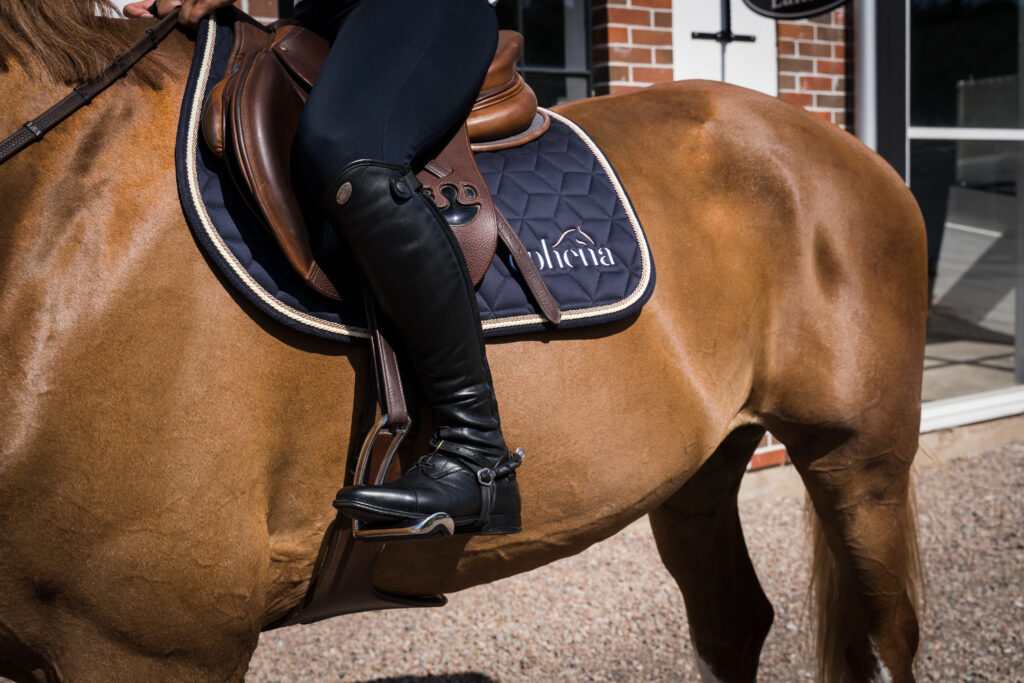Last updated: January 15, 2022
Stirrups are essential to riding a horse, but an element of the saddle most horseback riders take for granted. Have you wondered about the history of the stirrup? I have so I did some research to learn more about the history of the stirrup.
Saddle stirrups have a rich history. The earliest known use of stirrups is from the 2nd-century B.C.; these were small loops of material attached to the saddles and fit only the big toe. It was invented in India and is likely made of leather. This unique riding aid helped shape the world.
The development of the stirrup revolutionized horseback riding and changed how battles were fought. This small addition to horse riding gear made a substantial impact on world history.
Quick Links

Historical influence of stirrups
Stirrups give horseback riders stability. The stability gained by riding a horse with stirrups revolutionized the way wars were fought. In achieving balance, a rider could move faster with his steed and strike his opponents with deadly force.
Cavalries were organized, and their advantages over infantries were devastating. The advent of stirrups is surpassed only by the development of gunpowder in its effect on a society’s ability to wage war.
When historians lecture about inventions that have shaped the world, most will neglect to mention the effect the simple stirrup had on history. However, their impact should not be undervalued. Let’s look at some of the ways stirrups played a role in world history.
Stirrups aided the Mongols in building an empire.
With the help of stirrups, Genghis Khans‘ Mongols were able to emerge from Asia and rule the world’s largest land empire. The Mongols were great horsemen and skilled warriors.
They developed their own, new style of warfare waged from the backs of horses. Riding with stirrups, they were an unstoppable force. Stirrups allowed the Mongol riders to retreat, spin in the saddle and shoot a bow while their horse was in a full run.
Europeans were not ready for a force like Ghengis Khan’s. The Mongols would attack, retreat, and then attack again while always shooting arrows. The ability of these great horsemen to maintain balance while firing arrows led to the demise of many of the European infantrymen.
The Mongols military success was made possible by a simple tool, the stirrup. I recommend reading my article on horse breeds used in warfare for more information.
The advent of stirrups changed European calvary’s.
The Avars, refugees from Central Asia, first introduced the stirrup to Europe. These horse soldiers, rampaged across Europe using similar tactics displayed by Ghengis Khan.
The European foot soldiers were at a disadvantage, but soon they would start using stirrups, and when they do, they transform into an unstoppable force.

Stirrups allowed the cavalry to wear armor.
The stirrups’ introduction to the European cavalry occurred in the 8th Century. Before stirrups, armored knights rode horses to battle, but they were unable to balance and fight effectively.
This new tool allowed riders to wear armor and carry heavy weapons such as swords and lances into battle while staying balanced on their horse. Charles Martel, otherwise known as Charles “the hammer” was the King of France during this period.
Charles The Hammer fought and won battle after battle across Europe with a winning combination of heavy cavalry and veteran infantry. His armies fought off Arab invasions again and again until they were finally defeated in 737.
Charles, knowing the advantages of having skilled mounted warriors (knights) awarded the most talented fighters with grants of land and ushered in the beginnings of the feudal system, which would change Europe forever.
Stirrups arrive in England during the 10th century.
Although the stirrup made its way through Europe much earlier it first reaches England in the 10th Century. In the 10th century Vikings began attacking England. These raiders brought with them saddles with stirrups.
England quickly recognized the utility of stirrups and incorporated them shortly afterward. The stirrup brought changes in warfare and society that lasted for almost two thousand years and changed the landscape of Europe.
Did the Greeks and Romans have Stirrups?
Alexander the Great and his father Phillip II used their cavalry to wreak havoc across the globe. Their ability to use horses so well made me wonder if they used stirrups.
The Romans didn’t have stirrups. They rode their horses with high saddles and held on to their horses tightly using their legs. The stirrup didn’t arrive in Europe until well after the Roman invasions.
The Greeks and Romans often dismounted their horses and fought on the ground while some military units fought using horse-drawn chariots.
The horses were used to attack opposing defenses and move large numbers of troops, but it was too difficult for soldiers to maintain their balance and effectively fight from horseback prior to stirrups.
The Origin of the Modern Stirrups.
Horses were ridden with a simple blanket for years after they were domesticated. China introduced the leather saddle in the third century B.C. However, these saddles didn’t have stirrups, and it wasn’t until the fourth century A.D. that the Chinese began to fashion iron and bronze foot support. These supports are the predecessor to the modern-day stirrup.

The stirrup was first used in China.
The first known depiction of a rider with paired stirrups was found in China and believed to date back to 300 A.D. By 477 A.D. the stirrup was in widespread use across China. Before stirrups could be used a proper saddle tree had to be developed.
Early saddle trees in the first century B.C. were used in China, and the Roman cavalry but stirrups were not attached. The saddle tree provides support across a horses’ back and prevents injury when a rider is using stirrups. However, modern treeless saddles use stirrups without hurting horses.
English stirrups.
English style stirrups are stirrups used on English saddles. These stirrups are used in a variety of equestrian events, such as jumping, dressage, and racing.
They can be made of different materials and have different designs depending on their intended use. The following are some of the more commonly used English riding stirrups:

Magnetic Safety Stirrups
A modern twist on the classic English stirrups is the magnetic safety stirrups by Ophena The Ophena stirrups have a completely open design to minimize the risk of your foot catching in the stirrups in case of a fall.
This unique product has a few intriguing features that make them worth a try, such as its ease to attach and detach from the saddle. However, the most innovative part is the integrated magnetic system that keeps your feet in place and helps you improve your riding.
The stirrups come with a pair of magnetic insoles that you simply insert into your regular riding boots and the magnetic connection is established. But what’s most impressive is the reception it’s received in the equine community.
Over 1000 customers have rated it 5-stars. So far they are approved for Jumping competitions. The riding community seems to love these stirrups and Ophena confidently offers a 60-day money-back guarantee to all customers.
Meaning that you can order and try them out for 60 days and – if you’re not fully satisfied – Ophena will help you return your stirrups for a full refund.
When you read the reviews, you’ll find that people seem to fall in love with these stirrups. There are countless comments about better balance, improvements of posture and leg position, and overall higher confidence and better riding experience.
Many reviews also highlight the product quality and customer service. Ophena currently sells two models: The entry-model Ophena S, and a version with even more grip aimed at professionals, called the Ophena S Pro.
Both models have the same magnetic system, but the Ophena S Pro provides even more grip due to its spikey aluminum tread. As one reviewer puts it: “I’ve been on a hunt to find the best stirrups and have bought over 30. This one is the best one yet so safe yet so simple love everything about it!” That level of reviews combined with the money-back guarantee really seems to make trying these stirrups a no-brainer.
The English stirrup has an open oval-shaped bottom.
A stirrup pad covers the bottom portion of the stirrup; the pad helps a rider maintain foot position while riding.
The standard English stirrup is used for general riding and showing horses. The English stirrup comes in slight variations depending on personal riding preference. Korsteel Knife Edge Stirrup Iron 4.5
Jointed English stirrups are flexible.
These stirrups are made with a joint link in the upper portion of the stirrup. This stirrup is flexible, lending to a more comfortable ride. It’s a favorite stirrup of jumpers and eventers. They are also made so a rider’s foot can easily slide out. English Riding Flex Fillis Iron Double Jointed Stirrups
Safety stirrups are designed to prevent feet from hanging up in a stirrup.
These stirrups are made so a horseback riders’ foot can easily slide out of the stirrup. Some of the safety stirrups are designed with a breakaway branch and some have an outwardly curved side allowing for a smoother foot release. Intrepid Foot Free Safety Iron Stirrup,
English Fillis stirrups are used in dressage.
These stirrups are used in dressage and showing horses. They are similar to the standard English stirrup but more substantial and thicker, making them easier to recover when riding. Coronet Premium Fillis Stirrup Irons, 4 3/4-Inch
English endurance riding stirrups are designed for long horseback rides.
If you intend to spend long hours in the saddle, then you should invest in endurance trail riding stirrups. They are designed wide, with good padding to prevent soreness while riding. They also help to prevent chafing caused by constant rubbing on the stirrup leathers. English Aluminum Safety Flex Caged Endurance Stirrups Blue
What are Peacock Stirrups?
When I first heard someone ask to use peacock stirrups I had no idea what they were. I imagined a really strange stirrup, but before I let my mind wander too far, I decided to do some research.
A Peacock Stirrup is a safety stirrup usually used by beginning riders or children. The Peacock has an elastic band that allows a rider’s foot to come free of the stirrup in case of a fall. It looks like an English stirrup with an elastic band instead of full metal construction.
Western stirrups.
Western stirrups are made in a variety of styles for multiple purposes. The following are some of the more familiar western stirrups used today.
Western bell stirrups are the most common stirrup used with western saddles.
The western bell stirrup is shaped like a bell and is the most common stirrup used with western saddles. They are usually made of wood with metal trim but can also be constructed from metal or plastic. It is used for general riding and showing horses.
Curved western stirrups are often used in western event competitions.
The curved western stirrups are made in a variety of styles, depending on their use. Some are angled for the rider’s comfort or safety. Because of their versatility, they can be seen in reigning competitions, trail rides, and rodeos.
Oxbow western stirrups are similar to bell stirrups but have a more oval shape.
The oxbow stirrup is a standard western stirrup. The name comes from its round shape. The oxbow stirrup has a narrow footrest, making it unsuitable for long rides.
You see them often on old-styled saddles. The oxbow stirrup varies in design from plain to ornate. This stirrup is used for general riding or showing. The western oxbows curve design allows your foot to slip out if you’re falling.
Hooded western stirrups prevent the riders foot from slipping forward through the stirrup.
Hooded stirrups are western stirrups with a leather strip attached to the front of the stirrup. This leather cover prevents the rider’s foot from slipping through and provides foot protection from brush, branches, and the cold. The protective covering is called a tapadero. They are used for trail riding and children.
Kids slip-on stirrups are simple to use and allows small children to use stirrups.
Kids slip-on stirrups lay across the saddle and make it easy for children to ride with an adult. They are made of durable nylon and adjust to the length you need.
I’ve done extensive research into the best possible western and English stirrups I could find. The following stirrups are rated 5 stars on Amazon. It’s always prudent to gather as much information as possible before buying a product. Below are links to Amazon customer review pages so you can see for yourself what other customers have to say:

About the Author: Miles Henry
Lifelong Horseman | Racehorse Owner | Published Author
Miles Henry brings over 25 years of hands-on experience training and owning Thoroughbred racehorses. Raised with Quarter Horses and Appaloosas, he’s spent a lifetime learning from horses—on the track, in the barn, and in the field. Today, he runs a small but successful racing stable in Louisiana and shares real-world insights on HorseRacingSense.com, helping horse owners, fans, and bettors navigate the sport with confidence.
📚 Books: View Miles’s books on Amazon »
🎧 Podcast Guest: Animal Tales Ep. 32 |
YouTube Interview
📩 Newsletter: Sign up for racing tips and horse care advice »
🔗 Follow Miles:
Twitter |
Facebook |
YouTube













